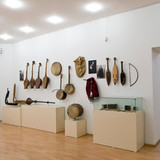Tbilisi State Museum of Georgian folk music and musical instruments
-
-
Avlabari, st. Samgebro Street (road to the castle Narikala), 6
-
- +995 032 2 457 721
-
11:00 to 18:00 tue-sn
-
-
About us
In 1975 the museum was established on the basis of the Museum of Theatre, Music, Cinema and Choreography. Its funds possess samples of musical instruments of Georgia, Caucasus, Russia and Western Europe. There are more than 5,000 exhibits in museum. The centre of the collection is the mechanical musical instruments provided by collector A. Revazishvili. His collection includes chonguri, diplipito, disharmony, street organs and music boxes. Museum had different names. Until 1984 it was called "The Museum of Folk Musical Instruments" and later "The Museum of Folk music and musical instruments".
The most significant and valuable part is the museum collection of Georgian musical instruments. Among the most ancient exhibits you can find the oldest triple-flute from Mtskheta. Also museums has salamuri (Lurch) from Samegrelo and sannori from Guria, Svaneti harmony with narrow range of sound, a sort of bagpipes gudostvari from Racha and chiboni from Adjara. The cases of these instruments, decorated with gold, colored glass and chains are interesting to observe as well.
Traditional Georgian polyphonic singing is represented in a collection of audio recordings, the first of which was made in 1901. Recordings are typically for Guria's and Migreliya's discordant singing. The life and work of Ratil, A. Benoshvili, E. Chhinvadze, I. Kargorateli and other choreographers and composers represented in the museum tell the history of the development of vocal art in Georgia.
Another exposition is devoted to the history of sound recording equipment: phonographs, gramophones, etc.
In the halls with exhibits of oriental music you can see the strings, bow and percussion musical instruments from the Middle East such as kamancha, duduk, doli, tar and saz.
Western part of the fund represents a collection of mechanical musical instruments like harmonicon "Bonaparte", shaman-argasha produced at the factory of Tbilisi "Nechada".



